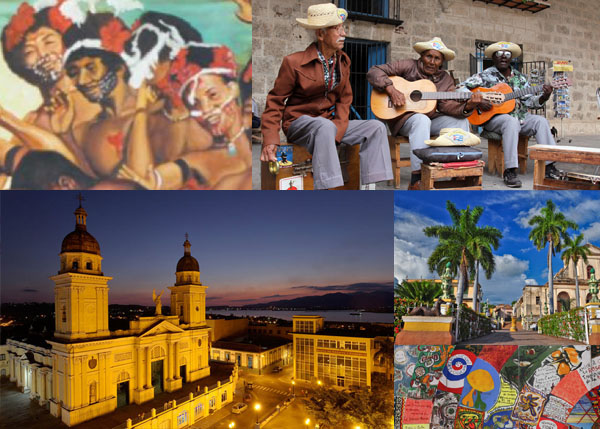11.2 Foundation of cultural organizations, educational institutions and music companies.

One of the main and most important objectives set by the revolutionary government was to raise the educational and cultural levels of the Cuban people. The latter constitutes one of the elements that define and distinguish a nation’s identity.
It began with the literacy campaign carried out throughout the country in 1961. The process of transformation continued with the founding of cultural institutions and organizations to disseminate and develop culture on the island through these organizations.
The Guillermo Tomás Bouffartigue Music Conservatory (San Juan Bosco No. 57, Guanabacoa, Havana), reopened in July 1959. It is located in the famous Villa de la Asunción in Guanabacoa. It is considered one of the most comprehensive in the Art School System, preparing students at the Elementary and High School levels. Each school year, it graduates an average of 40 students, who complete their training as professional musicians.
The Union of Writers and Artists of Cuba (UNEAC) is a social organization with cultural and artistic purposes, founded in 1961 by Cuban National Poet Nicolás Guillén. Miguel Barnet serves as its current president, and this organization includes the Musicians Association among its five associations. Its objectives include stimulating, protecting, and defending intellectual and artistic creation, as well as recognizing the broadest possible creative freedom.
The National School of Art (ENA) (120th Street between 9th and 13th Streets, Cubanacán, Playa, Havana) was founded in 1962, known as the City of the Arts. It is a center for the combined arts: ballet, music, drama, visual arts, modern and folk dance, and circus. The creation of this educational center was based on the experience of professors and virtuosos in the field. Its foundation also made possible the development of an arts education system.
The Musical Recording and Publishing Company (EGREM) (1008 3rd Street between 10th and 12th Streets, Miramar, Havana) was founded in 1964. The company has several subsidiaries located throughout the country. It is responsible for the production, promotion, distribution, and marketing of phonographic productions, among other tasks, both on the island and abroad. The record label consists of five recording studios located in three facilities.
The National Music Museum (Prison No. 1 between Habana and Aguiar Streets, Old Havana, Havana) was founded in 1971 and is an institution dedicated to the historical development of Cuban music. The history of Cuban and world music is the main reason for its creation. It is comprised of ten exhibition halls, five permanent rooms, and five temporary rooms. The National Music Museum (Prison No. 1 between Habana and Aguiar Streets, Old Havana, Havana) houses a large collection of folk musical instruments, rare instruments, and valuable sheet music of key pieces of Cuban music.
The Manuel Saumell Elementary Music School (660 F Street, Vedado, Havana), formerly known as the International Conservatory, is located in the Vedado neighborhood of Havana. It took its name from the renowned Cuban pianist in 1971. The school trains future Cuban musicians at the elementary level, many of whom are currently prominent figures in Cuban culture, such as Ilmar López-Gavilán, X Alfonso, Haydeé Milanés, Aldo López-Gavilán, and Niurka González Núñez, among others.
In 1974, the first national reorganization of art education took place, building on 12 years of artistic work and with the cooperation of educators from the former Soviet Union. This made it possible to implement the curriculum plans and programs for the various artistic forms in the country.
An initial project was also organized on the network of centers that currently comprise the National System of Art Education. The National Center for Art Schools (CNEART) (90 A Street, No. 9005, corner of 5th A, Miramar, Playa, Havana), constitutes an art education complex and is comprised of 47 schools (24 elementary and 23 middle schools) throughout the country. A Vocational Art Schools program was then created, which would provide each province with a specialized institution for elementary studies in the different branches of the arts.
The university-level arts school, the Instituto Superior de Arte (ISA) (1110 120th Street between 9th and 13th Streets, Cubanacán, Playa, Havana), was founded in 1976. The ISA’s academic structure (1110 120th Street between 9th and 13th Streets, Cubanacán, Playa, Havana) has expanded to include two branches in the provinces of Holguín and Camagüey, and a teaching unit in Santiago de Cuba. It also comprises four faculties: the three original faculties and the Faculty of Audiovisual Media Arts. This has led to an increase in the number of profiles, which now total 39.
The Ministry of Culture (2nd Street between 11th and 13th Streets, Vedado, Plaza de la Revolución, Havana) was created in 1976. It is an organ of the Central Administration of the State of the Republic of Cuba. Its task is to direct, guide, control, and execute, within its jurisdiction, the cultural policy of the State and the Cuban Government, as well as to guarantee the defense, preservation, and enhancement of the cultural heritage of the Cuban nation.
With the creation of the Ministry of Culture (Calle 2 e/ 11 y 13, Vedado, Plaza de la Revolución, Havana), cultural activity in the country is organized, together with the institutions that are created and that are responsible for promoting and developing said activity.
The Center for Research and Development of Cuban Music (CIDMUC) (Calle G No. 505 between 21 and 23, Vedado, Havana) was founded on December 26, 1978. It was created with the vital and faithful purpose of promoting and encouraging knowledge, research, development and general information concerning Cuban music.








